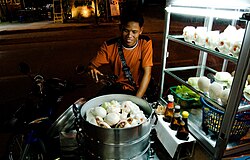Siopao
  Top: Siopao buns with pork bbq filling; Bottom: A street vendor in Chiang Mai, Thailand, selling various types of salapao | |
| Alternative names | Salapao (Thailand), Manapua (Hawaii) |
|---|---|
| Type | Baozi |
| Course | Snack, Cuisine |
| Place of origin | Philippines |
| Serving temperature | Hot |
Food energy (per serving) | 0.33 kcal (1 kJ) |
Siopao (simplified Chinese: 烧包; traditional Chinese: 燒包; Cantonese Yale: sīu-bāau; Pe̍h-ōe-jī: sio-pau; lit. 'hot bun'; Tagalog pronunciation: [ˈʃopaʊ]), is the Philippine indigenized version of the Cantonese steamed bun called cha siu bao.[1] In Chinese, it is called baozi. It is popular to both Chinese and Filipino restaurants and it is commonly part of dim sum cuisine.
Description[]
Siopao is a popular snack sold mostly by bakeries and vendors and in many Chinese restaurants and eateries in the Philippines. There are various varieties based on the filling: pork asado or bola-bola (a combination of pork, chicken, beef, shrimp or salted duck egg). There are a variety of ways to bake it. [2]
A unique variant from Siargao Island is the paowaw, a dessert bun which has a filling of bukayo (sweetened shredded coconut meat).[3]
An old urban legend or canard alleges that siopao is made from cat meat, due to the relative cheapness of siopao and Sinophobia.
Siopao was popularized in (if not introduced to) the Philippines by Ma Mon Luk, a Cantonese immigrant street vendor who created mami around the 1920s. After he opened up his eponymous restaurant years later, he promoted siopao by giving samples from door to door, as well donating it as free food for disaster victims. Siopao and siomai were served as side dishes for his signature mami. His restaurant became very popular, ensuring siopao's popularity to this day.
In other countries[]
The Chinese version of Siopao is a vegetable or meat-filled baozi. Baozi was first produced during the Three Kingdoms period in China between 220 and 256 A.D. Originally, Siopao was called mantou or flour-head.
There is a similar derivative in Thai cuisine called salapao (Thai: ซาลาเปา), which is sometimes made with a sweet filling for a dessert.[4] It is also a favorite in Hawaii where it is called manapua.
See also[]
- Asado roll
- Cha siu bao
- Bāozi, the Chinese version of the steamed bun.
- Ma Mon Luk
- List of buns
- List of steamed foods
 Food portal
Food portal
References[]
- ^ Frances Lorraine Haw-Ang (August 25, 2010). "Top 10 Siopao in Manila". www.spot.ph. Retrieved 21 December 2010.
- ^ http://www.mixingbowl.com/content/GELACIOSFILIPINOAMERICANRECIPES/recipe/5805221/Baked-Siopao[permanent dead link]
- ^ Damo, Ida. "Two Unique Snacks from Surigao: Paowaw & Milledo". ChoosePhilippines. Retrieved 28 July 2019.
- ^ "Salapao – Chinese Steamed Buns". www.thaizer.com/. January 15, 2010. Retrieved 21 December 2010.
- Dumplings
- Steamed buns
- Thai desserts and snacks
- Chinese fusion cuisine
- Philippine fusion cuisine
- Stuffed dishes
- Chinese cuisine stubs
- Thai cuisine stubs
